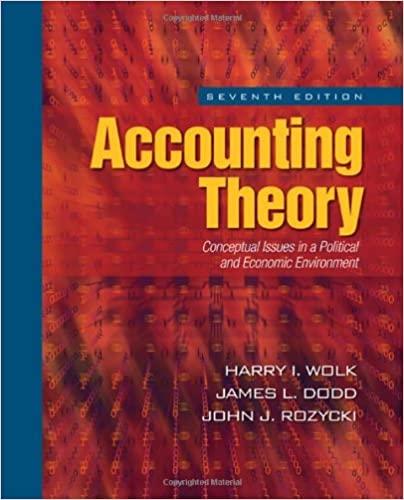Answered step by step
Verified Expert Solution
Question
1 Approved Answer
Economic income and accounting income are always the same. Economic income and accounting income are always the same. True False The matching principle in accounting
Economic income and accounting income are always the same. Economic income and accounting income are always the same.
True False
The matching principle in accounting prescribes that costs must be recognized in the same period
when the related revenues are recognized.
True False
For item to be considered extraordinary, it should be either unusual in nature or infrequent in
occurrence.
True False
A longterm asset is said to be impaired when its fair value is below its book value.
True False
Income from continuing operations is a measure that excludes certain nonrecurring items, such as
extraordinary items, and the effects of discontinued operations, from net income.
True False
Multiple Choice Questions
As a general rule, revenue is normally recognized when it is:
A measurable and earned.
B measurable and received.
C realizable and earned.
D realizable and measurable. Which of the following measures of accounting income is typically reported in an income statement?
A Net income
B Comprehensive income
C Continuing income
D All of the above
Brierton Company enters a contract at the beginning of year to build a new federal courthouse
for a price of $ million. Brierton estimates that total cost of the project will be $ million and will
take four years to complete.
Costs incurred Payments from federal
Year
Year
Year
Year
$ million
$ million
S million
$ million
government
$ million
$ million
$ million
$ million
If Brierton used percentageofcompletion method to account for this project, what would they have
reported as profit in year
A
B $ million
C $ million
D $ million
Compared with companies that expense costs, firms that capitalize costs can be expected to report:
A higher asset levels and lower equity levels.
B higher asset levels and higher equity levels.
C lower asset levels and higher equity levels.
D lower asset levels and lower equity levels. Chapter Exercises
Wr
iil Loss a invertory resulting from a fire
W Lioss resuifting form a sitrike
A arg iV
C ill Iy
E IH sntiti
True
False
The matching principle in accounting prescribes that costs must be recognized in the same period
when the related revenues are recognized.
True
False
For item to be considered extraordinary, it should be either unusual in nature or infrequent in
occurrence.
True
False
A longterm asset is said to be impaired when its fair value is below its book value.
True
False
Income from continuing operations is a measure that excludes certain nonrecurring items, such as
extraordinary items, and the effects of discontinued operations, from net income.
True
False
Multiple Choice Questions
As a general rule, revenue is normally recognized when it is:
A measurable and earned.
B measurable and received.
C realizable and earned.
D realizable and measurable.
Which of the following measures of accounting income is typically reported in an income statement?
A Net income
B Comprehensive income
C Continuing income
D All of the above
Brierton Company enters a contract at the beginning of year to build a new federal courthouse
for a price of $ million. Brierton estimates that total cost of the project will be $ million and will
take four years to complete.
If Brierton used percentageofcompletion method to account for this project, what would they have
reported as profit in year
A $
B $ million
C $ million
D $ million
Compared with companies that expense costs, firms that capitalize costs can be expected to report:
A higher asset levels and lower equity levels.
B higher asset levels and higher equity levels.
C lower asset levels and higher equity levels.
D lower asset levels and lower equity levels.
Which of the following would be considered an extraordinary item?
I. Writedown of receivables
II Gains on disposal of a business segment
III. Loss of inventory resulting from a fire
IV Loss resulting from a strike
A I and IV
B I, III, and IV
C III only
D I, II and III

Step by Step Solution
There are 3 Steps involved in it
Step: 1

Get Instant Access to Expert-Tailored Solutions
See step-by-step solutions with expert insights and AI powered tools for academic success
Step: 2

Step: 3

Ace Your Homework with AI
Get the answers you need in no time with our AI-driven, step-by-step assistance
Get Started


